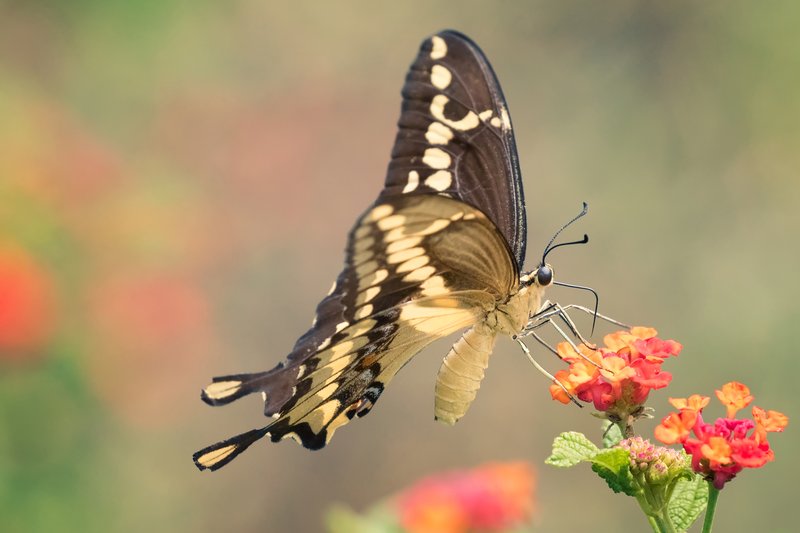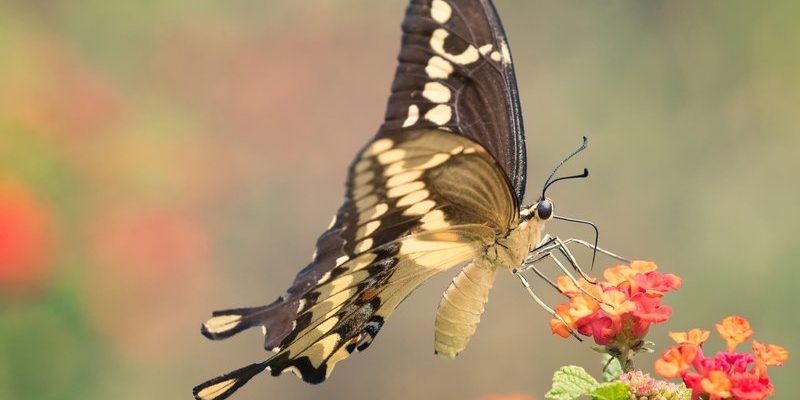
Think of climate change like someone adjusting the thermostat in a cozy café, changing it from a comfortable warmth to a blazing heat. For swallowtail butterflies, this new temperature can affect everything from their food supply to where they can safely live. In this article, we’ll look at how climate change is altering the habitat, behavior, and survival of these stunning creatures.
Understanding the Swallowtail Butterfly
Swallowtail butterflies belong to the family Papilionidae, and they are known for their striking colors and distinctive tail-like extensions on their hindwings. There are numerous species, such as the Eastern Tiger Swallowtail and the Black Swallowtail, each boasting unique patterns and sizes. Depending on where they live, their colors can range from dazzling yellow to deep blue or black.
These butterflies are more than just eye candy. They play an important role in maintaining the health of ecosystems by pollinating plants as they gather nectar. Think of them as little gardeners, helping flowers bloom and produce seeds, which in turn feeds other wildlife and maintains plant diversity.
You might be wondering what makes swallowtails so special. Their larvae, or caterpillars, often feed on specific native plants. This reliance on particular species makes them vulnerable to changes in their environment, especially shifts caused by climate change.
How Climate Change Affects Butterfly Habitats
Just like us, swallowtail butterflies have specific habitat needs. They thrive in areas where their primary food sources, such as certain flowers or host plants, grow abundantly. Unfortunately, climate change is altering these environments—think of it as a gardener uprooting the plants you love most and replacing them with ones that don’t thrive.
Rising temperatures can lead to changes in blooming seasons. For example, if flowers bloom earlier in the year due to warmer spring temperatures, there’s a chance that the swallowtail’s lifecycle might not sync up. If the caterpillars hatch too late, they might find their favorite flowers have already wilted, leaving them with less food.
Additionally, habitat loss due to urban development and changing land use practices exacerbates the issue. Swallowtails rely on specific plants to survive, and as these plants disappear, their chances of survival dwindle. It’s like losing access to your favorite grocery store—you might find yourself hungry and searching for alternatives.
Altered Migration Patterns
Migration is a crucial part of many butterflies’ life cycles, and swallowtails are no exception. These insects often travel long distances to find suitable habitats. Unfortunately, shifting climate conditions can disrupt these migratory routes, akin to someone accidentally blocking your favorite shortcut to work.
As temperatures change, the timing of these migrations can become misaligned. If the weather warms too quickly, it may lead to earlier departures. However, if the food sources haven’t bloomed yet, these butterflies can arrive at their destinations to find nothing to eat. This mismatch can lead to population declines, as butterflies may struggle to find sustenance.
You might see some swallowtail species starting to migrate earlier or further north than before, trying to find cooler areas where they can thrive. While adaptability can be a good thing, it leaves these creatures vulnerable. Not all habitats can support them, and sudden changes can leave them stranded in areas that aren’t suitable for survival.
The Impact on Swallowtail Reproduction
Reproduction is another critical area where climate change can create heavy impacts. Swallowtail butterflies must find the right conditions to mate and lay eggs, often depending on specific plants that may be affected by changing temperatures. If temperatures surge too high or fall unexpectedly, it can disrupt their reproductive cycles.
In the event of extreme weather, such as unseasonably cold snaps or prolonged droughts, female swallowtails may not be able to find suitable host plants to lay their eggs on. This is like a parent trying to find a safe place for their child to play only to discover all their favorite parks have been closed.
Moreover, warmer conditions can lead to a rise in certain predators or pests that can impact swallowtail populations, further complicating their ability to reproduce successfully. If they can’t reproduce effectively, their populations may dwindle, threatening their survival as a species.
Conservation Efforts for Swallowtail Butterflies
With the challenges posed by climate change, various efforts focus on protecting swallowtail butterflies. Conservation organizations work to create habitats that offer the plants and flowers these butterflies need, ensuring they have a safe space to thrive. It’s like setting up a butterfly sanctuary—an oasis in a changing world.
One approach involves planting native species of plants that cater to the needs of these butterflies. This way, we can create more habitats, especially in urban areas where natural landscapes are disappearing. Simple actions, like planting butterfly gardens in your yard or community spaces, can significantly help these delicate creatures.
Additionally, researchers are studying swallowtail populations to understand their behaviors and adapt conservation efforts accordingly. By monitoring changes and tracking butterfly movements, we can develop informed strategies to protect them, addressing climate change’s impact more effectively.
What Can You Do to Help Swallowtails?
You don’t have to be a scientist to help swallowtails thrive. There are several simple steps you can take to contribute to their conservation. Start by creating a welcoming environment in your own backyard or community:
- Plant native flowers that provide nectar and host plants for caterpillars.
- Avoid pesticides, which can harm butterflies and their larvae.
- Create water sources, such as shallow dishes with stones, where butterflies can drink safely.
Every small action counts. If more people become aware of how climate change affects wildlife like swallowtail butterflies, it can lead to collective efforts for change. Remember, these butterflies are not just beautiful; they are part of our ecosystem and need our help to survive.
Final Thoughts
The impact of climate change on the swallowtail butterfly is a vivid example of how interconnected our world is. From habitat loss to altered migration patterns, these butterflies face significant challenges in a rapidly changing environment. Yet, by understanding their plight and taking action, we can help protect these stunning creatures and ensure they continue to grace our gardens and landscapes.
So the next time you see a swallowtail fluttering about, take a moment to appreciate not just its beauty but the challenges it faces. Let’s work together to create a world where these butterflies can thrive, and remember, every action counts—big or small. Together, we can make a difference!

